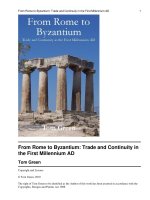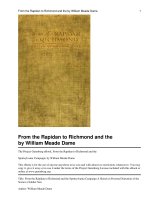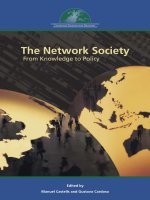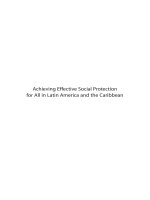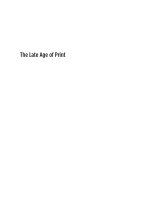From hinterland to ecological footprint the singapore cameron highlands vegetable trade
Bạn đang xem bản rút gọn của tài liệu. Xem và tải ngay bản đầy đủ của tài liệu tại đây (17.01 MB, 182 trang )
FROM HINTERLAND TO
ECOLOGICAL FOOTPRINT:
THE SINGAPORE-CAMERON HIGHLANDS’
VEGETABLE TRADE
TAN PENG TING
(B.Soc.Sci (Hons.), NUS)
A THESIS SUBMITTED FOR THE DEGREE OF MASTER OF SOCIAL SCIENCES
DEPARTMENT OF GEOGRAPHY
NATIONAL UNIVERSITY OF SINGAPORE
2012
"
"
"
DECLARATION
I hereby declare that this thesis is my original work and it has been written by me in its
entirety. I have duly acknowledged all the sources of information which have been used
in the thesis.
This thesis has also not been submitted for any degree in any university previously.
___________________
Tan Peng Ting
16 August 2012
"
"
"
"
ACKNOWLEDGEMENT
Dedicated to my late father, my ardent fan
who was unable to see this dissertation to its completion.
This dissertation would not be possible without the patient guidance and
enlightening advice of my thesis supervisor A/P Victor Savage; the love and support of
my husband and family; the farmers of Cameron Highlands for sharing their food, farms
and stories with me; and Mr Chua for opening his home to us.
Thank you to the marvellous friends and assistants, who toiled in field with me,
kept loneliness away, participated with curiosity and allowed me to share in their
discovery of where our food comes from.
This dissertation has taken five years and seen through many life events from
marriage, births to illness and death. I could not have kept going without all the support
and encouragement from closest friend to remote acquaintances on Facebook who
cheered me on these past six years.
Tan Peng Ting
16 August 2012
I"
"
"
"
"
TABLE OF CONTENT
Declaration
1.
2.
Acknowledgement
i
Table of Content
ii
Abstract
iv
List of Figures
vi
List of Tables
vii
List of Plates
viii
Introduction
1
1.1
Research Aims
5
1.2
Conceptual Framework
6
1.3
Methodology
23
1.4
Literature Review
30
Background of Singapore-Cameron Highlands Relations
36
2.1
Geography
37
2.2
Agricultural Hinterland
39
2.3
Rise of Alternative Marketing Systems
44
II"
"
"
3.
4.
5.
"
"
2.4
Export Consumption and Agricultural Expansion
47
2.5
Divergence and Embargoes
56
2.6
Changing Farming Methods
62
Singapore’s Ecological Footprint on Cameron Highlands’ Environment
3.1
Respondents’ Profile
72
3.2
Survey Results
77
3.3
Pesticide Use
83
3.4
Farm Expansions
100
3.5
Land Levelling
109
Future Trends and Directions
115
4.1
124
Singapore’s Evolving Footprint
Conclusion
134
5.1
141
Recommendations
Bibliography
148
Appendices
Appendix A: Farm Survey Template
170
Appendix B: Business Decision Ranking Questionnaire
171
III"
"
"
"
"
ABSTRACT
Metropolitan areas have a growing ecological footprint while urban consumption
and environmental degradation are quoted as some of the “most pressing global issues”
today. Singapore, as a resource-scarce city-state that imports 98 per cent of its vegetable
consumption is a perfect case study in studying ecological footprint. The city-state
imported 28,872 tonnes of tomatoes (94%), 22,756 tonnes (95%) of cucumbers and 3,424
tonnes of lettuce (81%) from Cameron Highlands, Malaysia in 2010. Cameron Highlands
is a major vegetable cultivation area in Malaysia, producing 40 per cent of total vegetable
production in Malaysia. The colonial hill station, situated 1,070 to 1,830m above sea
level, has a climate suited for cultivating temperate vegetables and has been supplying
vegetables to Malaysia and Singapore since 1933. However, when Singapore gained
independence from Malaysia in 1965, it was also separated from this traditional
hinterland.
Through historical analysis and interviews with producers and actors along the
commodity chain, this study finds that Singapore’s consumption and ecological footprint
impacts the landscape on its transnational hinterlands in Cameron Highlands through 1)
pesticides regulations, 2) fuelling farm expansions and 3) levelling hills for creating
platform terraces to maximise yield and accommodate high-tech farms for luxury crops
for export. Singapore’s regulations had helped to raise the production standards, both in
quality and food safety, in Malaysia. However, the city-state faces the dilemma of
safeguarding food security by diversifying food sources and diluting its ecological
footprint while diminishing its ability to influence production practices in Cameron
IV"
"
"
"
"
Highlands. Instead, the State is no longer the most important actor in governing
environmental externalities and must now rely on forms of private governance.
Keywords: ecological footprint, agriculture, vegetables, Cameron Highlands
(Word Count: 36,113)
V"
"
"
"
"
LIST OF FIGURES
Figure 1: 5-Year Singapore Vegetable Imports from Malaysia
Figure 2: Per Capita Consumption Trend over Past 10 Years
Figure 3: Ethnic Composition of Cameron Highlands Population
Figure 4: Conceptual Framework
Figure 5: Cameron Highlands Respondent Profile
Figure 6: Map of Cameron Highlands
Figure 7: Respondents’ Choice of Growing Method and Market Destination by Farm Size
and Ethnicity
Figure 8: Market Destinations of Cameron Highland Vegetables by Market Share
Figure 9: Factors Influencing Farming Practices (Sorted by Market Destinations)
Figure 10: Factors Influencing Farming Practices (Sorted by Crop Choice)
Figure 11: 25 Years Trend of Temperature at Cameron Highlands (1984-2007)
Figure 12: GDP Per Capita of Singapore and Malaysia (1959 – 2010)
Figure 13: Map of Second East-West Highway Route
Figure 14: Satellite Image of Lojing, Kelantan
Figure 15: Map of New Access Routes to Cameron Highlands
Figure 16: Median Gross Monthly Income in Singapore (2001 to 2011)
VI"
"
"
"
"
LIST OF TABLES
Table 1: Types of Crops and Production Area in Cameron Highlands
Table 2: Comparison of Tomato and English Cabbage Production in Cameron Highlands
Table 3: Summary of Key Themes in Literature on Cameron Highlands Agriculture
Table 4: Malaysia’s Export, Import and Self-Sufficiency Level in Vegetables, 1985 –
2005
Table 5: 1987 Cameron Highlands Vegetable Pesticide Residue Level and Allowable
Limits
Table 6: Respondent Demography by Market Destination, Farm Size and Growing
Method
Table 7: Comparison of Regulations Related to Pesticide Use in Malaysia
Table 8: Key Factors for Farm Expansion in Cameron Highlands
VII"
"
"
"
"
LIST OF PLATES
Plate 1: Farm in process of adding new soil material
Plate 2: High-Tech farms springing up on two sides of the new road through Lojing
Plate 3: Construction of new road to Kuala Lipis (background) through Bertam Valley
Plate 4: Several small traditional farms cultivated by different farmers
Plate 5: Cameron Highlands’ non-homogeneous agricultural landscape
Plate 6: Tomatoes grown by fertigation
Plate 7: NPK fertiliser mix distributed through the irrigation system
Plate 8: Bench Terraces
Plate 9: Platform Terraces
Plate 10: Agricultural waste discarded by stream banks
Plate 11: Bags of used peat moss discarded over hill slopes
Plate 12: Red Coral Lettuce grown by hydroponics
Plate 13: Red Coral Lettuce grown in soil
Plate 14: Farm labourers applying pesticides to crops
Plate 15: Yellow sticky traps used in integrated pest management
Plate 16: Daylilies grown on both side of the road and hill slopes
Plate 17: Vegetables packed in bamboo baskets and cardboard boxes for transporting
Plate 18: Packing vegetables in newspaper
Plate 19: Farmers washing and drying tomatoes
Plate 20: Machines to wash and dry tomatoes
Plate 21: Farm Expansion at Brinchang
VIII"
"
"
"
"
Plate 22: Scenes of High-Tech Farm Construction in Blue Valley, 2008
Plate 23: Deforestation and land levelling in progress at Lojing, Kelantan
Plate 24: New rain shelters installed at denuded and levelled hill in Lojing, Kelantan
Plate 25: Steep cliffs created from to maximise farm area
Plate 26: Landslide-damaged rain shelters
Plate 27: Primitive farm infrastructure of smallholdings without capital
Plate 28: Poor soil quality resulting in unequal and poor crop quality
Plate 29: Packing produce in Cameron Highlands for a Singapore supermarket chain’s
house brand
Plate 30: Organic Vegetables sold in a Kuala Lumpur Wet Market in Malaysia
Plate 31: Poster introducing the Cameron Highlands producers of the vegetables sold in a
Kuala Lumpur organic shop
!
!
IX"
"
"
"
"
CHAPTER ONE
INTRODUCTION
“Cities are unnatural… [they require a] concentration of food, water,
energy, and materials that nature cannot provide”
Lester Brown (2001: 188)
If cities are unnatural, then city-states are the oddities amongst the odd. Even as
cities often require food, water, and other resources imported from beyond its own
metropolitan boundary, city-states likewise require these resources but from across
transnational boundaries. With the rapid growth of urban centres globally, urban
consumption is proving to have a greater regional and global impact than before.
Metropolitan areas have a growing ecological footprint (Wackernagel and Rees, 1996a)
while urban consumption and environmental degradation are quoted as some of the “most
pressing global issues” today (Jorgenson, 2003: 374). As Savage (2006:50) pointed out,
the urban rich live on the provisions of a global hinterland and ecosystem. To better
understand the impact of urban areas, the experience of city-states offers the unique
perspectives from both a nation state as well as a highly urbanised area dependent on
resources beyond its boundaries. Already, there is a growing movement to view
metropolitan regions as “citistates” which are characterized by social, economic and
environmental interdependence (Peirce et al, 1993).
The island city-state of Singapore in Southeast Asia, one of only three city-states
in the world, is a perfect case study in studying ecological footprint. With a high per
1"
"
"
"
"
capita gross domestic product (GDP) of SGD$46,832 (Singstat, 2007), its population of 5
million (Singstat, 2010) has a strong purchasing power of SGD$18,000 in private
consumption per capita (Singstat, 2006). However, with a land area of just 710 km2, only
1% of the land (7.34 km2) is set aside for agriculture (AVA, 2009). According to the citystate’s Agri-Food & Veterinary Authority (AVA), Singapore imported 98% of its
418,000 tonnes of vegetable consumption in 2009 (AVA, 2009). In addition to household
consumption, Singapore’s tourism and port are key industries in its economy that further
contributed to the high consumption of largely imported food resources. The city-state
saw a total arrival of 11.6 million tourists in 2010 (STB, 2010) while its port saw an
arrival of 127,000 vessels in the same year (MPA, 2010).
Food is a population’s most basic of needs while agriculture is one of the largest
uses of freshwater globally at 66% of total withdrawal (Shiklomanov, 1999). In particular,
many authors have pointed out that upland vegetable farms cause extensive degradation
to the landscape through reduction in soils and deterioration in water quality (Aminuddin
et al, 2005; Midmore et al, 1996; Peh et al, 2011). By importing most of its food, the citystate is transferring its resource demand, environmental burden and food insecurity across
borders to producing areas. This exceedingly high food import dependency makes
Singapore ideal for the impact study of urban ecological footprint on the environment in
cross-border producing regions. Being a city-state with little domestic food supply, it is
better able to centralise tracking, monitoring and enforcement of food safety regulations
at the border customs, than most cities around the world with a domestic hinterland.
Increasing environmental awareness and food contamination scares has also led to greater
attention on food production practices and its governance. In turn, Singapore’s food
2"
"
"
"
"
dependency only makes it vulnerable to not only resource politics but also the
environmental quality, conditions and practices of producing countries. The globalization
of food systems has called for the identification of effective governance in a transnational
context. For many cities around the world like Singapore, previously urban-rural
agricultural issues within national boundaries have now become a dialogue between
global urban cities and transnational agrarian regions.
Figure 1: 5-Year Singapore Vegetable Imports from Malaysia
"
Source: IE Singapore
(2010)
Historically, Singapore was never self-sufficient in its food production. Prior to
1963, Singapore was a British crown colony and part of the larger geo-political region of
British Malaya. From 1963 to 1965, it joined the Federation of Malaya, Sabah and
Sarawak to become a part of Malaysia. Its vegetable consumption was fed mostly by
imports from China and Indonesia as well as domestic production across Malaya and
3"
"
"
"
"
locally in Singapore. When Singapore gained independence from Malaysia in 1965, it
was also separated from this traditional hinterland. Nonetheless, Malaysia continues to be
a major supplier (50%) of Singapore’s fresh vegetables (The Straits Times, 2007) albeit
with new international boundaries drawn. Of this supply, the majority of temperate
vegetables such as tomato (Solanum lycopersicum var.) and lettuce (Lactuca sativa var.)
are imported from the Cameron Highlands District in the Pahang State of Peninsular
Malaysia. While lowland vegetable farms are geographically dispersed and difficult to
isolate to one physical environment, the temperate vegetables in Malaysia have been
produced in Cameron Highlands and exported to Singapore over the past 80 years. In
2010, 94% of tomatoes, 95% of cucumbers (Cucumis sativus var.) and 81% of lettuce
consumed in Singapore are from Malaysia (See Figure 1). Out of the 25,000 tonnes of
tomatoes Singapore imported from Malaysia in 2007, the Malaysian Federal Agriculture
Marketing Authority approximated that 24,000 tonnes of the tomatoes were from
Cameron Highlands. Midmore et al (1996) cited Singapore as Cameron Highland’s key
export market – with minute amounts sometimes exported to Thailand, Japan and Taiwan.
Despite Malaysia being a net importer of vegetables, an approximate 25% of total
produce grown in Malaysia are exported to Singapore. At a more local level, almost 100%
of all vegetable exports from Cameron Highlands are to Singapore. Although Singapore
is very much dependent on its neighbour for its temperate vegetables, statistically
speaking, Singapore’s consumption may not be able to claim full responsibility for
impacts on Cameron Highlands’ temperate vegetables. However, Singapore’s strict
enforcement of food safety standards on imports at the custom has potential trickle-down
impact on the farming practices in the Highlands. Responding to public outcry during
4"
"
"
"
"
food scares and its consumers’ food safety demands, the city-state’s influence on farming
practices is further extended through trade embargoes as well as bilateral cooperation and
diplomacy between government agencies. In this globalised world where food is
imported and exported widely, impact of food consumption is usually diffused. Cameron
Highlands’ vegetable trade with Singapore offers insight into the black box of whether a
city’s consumption, policies and regulations has any influence on the environment and
farming practices of a food production source beyond its borders. For a city-state with a
strong food supply diversification policy, the ability to trace consumption to a welldefined physical landscape will shed light on the material impact of Singapore’s
ecological footprint on its transnational hinterlands.
1.1
Research Aims
Fiala (2008) pointed out that the concept of “ecological footprint fails to capture
one of the most important issues of sustainability, land degradation”. With this in mind,
this study examines the impact of consumption on the material landscape of food
production. This will be done particularly through studying the decision-making process
of vegetable farmers in Cameron Highlands that has been influenced by Singapore’s
consumption.
Having established that Singapore’s consumption of temperate crops, such as
tomatoes, cucumbers and lettuce, is largely from Cameron Highlands, this makes the
district a suitable candidate for studying the impact of Singapore’s consumption. At the
same time, the conversion of Montane forest to upland vegetable farms have caused
concern for increased landslides, loss of wildlife habitats and heavy siltation of dams and
5"
"
"
"
"
waterways (Midmore et al, 1996; Peh et al, 2011). While many studies have correlated
these environmental degradations to the profit driven vegetable farms and inferred the
importance of income from vegetable exports, there are no in-depth studies on the role of
cross-border Singapore consumers in this ecosystem. While environmentalists are
appalled by the hypothetical size of a city’s ecological footprints, there is little known
about actual material impacts on the physical landscapes in food producing areas. Do
urban consumers have a role to play in the environmental degradation – ecological and
biological losses, land degradation, water pollution – of its hinterlands?
Based on the assumption in ecological footprint research that consumption has an
impact on the environment of the production source, this study specifically aims to
a.
Uncover any impacts of Singapore’s vegetable consumption on the
environment of its produce origin in Cameron Highlands, Malaysia.
b.
Examine whether Singapore’s market forces or regulations are effective
transnational governance tools that can influence the Cameron Highlands
farmer’s environmental behaviour and decision-making when adopting
farming practices.
c.
Identify other factors that may influence or hinder the Cameron Highlands
vegetable farmers in the adoption of sustainable agricultural practices.
1.2
Conceptual Framework
As defined by the Dictionary of Human Geography (Johnson et al eds, 2000: 337),
hinterland is “the area for which the settlement is the trading nexus”. The hinterland is
6"
"
"
"
"
often represented as a tributary mode of production in the periphery where tributes flow
from the hinterland producers to the urban core (Wallerstein, 1974). Lewis W Jones
(1955: 40 – 41) suggested that the concept of “hinterland” implies interdependence
between that area and the “center” to which it is hinterland. This is especially true for
Singapore, which is dependent on its transnational hinterland for more than 90 per cent of
its food supply.
In early location theories such as Von Thunen’s model of agricultural land, there
is a clear correlation between the size of the hinterland and the size of the city as societies
were space bound and hinterlands were limited (Savage, 2006). However, with the advent
of technology, transportation is now faster, cheaper and mobility has increased. Yet at the
same time, Savage (2006: 59) points out that this in turn “buttresses the sustainability and
viability of these cities”. Savage and Kong (1993) argue that if the hinterlands are poor
and enveloped in environmental problems, the cities are likely to follow the same fate.
However, Singapore being a global city, it has a diverse and varied international
hinterland. Malaysia, which was historically Singapore’s local hinterland, is now beyond
national boundaries. Furthermore, with its wealth within a less developed region rich in
resources, it is well positioned to tap on the resources of its neighbouring hinterlands. It is
not constrained by the problems of any one particular hinterland. However, this has also
led to the increasing oblivion of Singaporeans towards the vulnerability of the countries’
food security. The prevalent “use and discard” mentality extends towards food production
sources. Savage (2006) explains this to be a global phenomenon extended towards all
urban rich. In many ways, this phenomenon is exacerbated in Singapore. Unlike most
cities that have domestic rural agricultural sectors, its citizens readily reap the world as its
7"
"
"
"
"
hinterlands, without responsibility for the problems of any hinterland (Savage and Kong,
1993).
In order to better understand the impact of Singapore’s consumption on its food
production sources, this study uses a commodity filière analysis approach to present a
holistic picture of Singapore’s highland vegetable consumption impacts on Cameron
Highland’s environment. The French term here refers to the chain of activities from
producer to the final consumer and is used interchangeably with the term “commodity
chain”. The filière approach involves “covering all (or most) processes and transactions
from primary processing to consumption” (Raikes, Jensen and Ponte, 2000:1). It maps
commodity flows, identify actors and activities as well as study the “product system”
which includes not only production but the regulation of trade, marketing and
consumption as well as vertical and horizontal relations between agents (Raikes, Jensen
and Ponte, 2000). The approach was first used for studying vertical integration in French
agriculture and often seen as a neutral tool of analysis. Its use in agricultural context and
comprehensive nature is especially suitable for the purposes of this study. Through
examining the commodity filière, or product system, as it shall be used in this dissertation,
one can then uncover the tangible impacts of Singapore’s ecological footprint.
Ecological Footprint
Ecological footprint is defined as the hypothetical “footprint” representing areas
of land needed for the consumption rate of a particular product or by a country
(Wackernagel and Rees, 1996). Singapore has an ecological footprint of 6.10 global
hectares per citizen in 2008 out of a world average of 2.7 hectares (GFN, 2012). This
8"
"
"
"
"
means that if the world’s population consumed at the same rate as Singapore, the global
ecological footprint would be 3.44 Planets (GFN, 2012a). Some may argue that the island
state’s encroaching ecological footprint is a precondition of a city-state. However from an
ecological standpoint, this could be the malady of a rich global city’s exploitation of the
world’s resources. After all, the impact of agriculture and global food consumption on the
environment is undeniable and well documented (Sutton and Anderson, 2004; Southgate
et al, 2007).
With the globalized nature of environmental problems today, distant consumers
will soon be unable to ignore the environmental problems of their hinterlands. The
vulnerability of Singapore’s food supply is clear from global food crises such as the 2008
rice shortage and declining exports from major rice producing countries (New York Times,
17 Apr 2008). Other examples include the bird flu and other viruses that have swept
through the livestock industries and affected the major source countries for Singapore.
The footprint may be effective in serving as an easy-to-understand indicator for
informing laymen and policymakers. However, to evaluate the effectiveness of existing
policies, it is important to understand realities on the ground and responses to policies by
producers.
Consumption and Market-Based Authorities
Dixon (2003) identifies three forces behind any restructuring of national food
systems:
1. Multilateral governance mechanisms and the role of transnational corporations
9"
"
"
"
"
2. Authoritative and reflexive consumers who use buying power and organising
capacity to demand certain attributes from the market
3. Activities of actors engaged in the distribution and exchange of goods and
services
These institutional actors and market-based authorities have become a driving
force in influencing and changing the behaviour of farmers and food production practices
around the world. The ethical reforms by the supermarket chains in the United Kingdoms
on their global supply chains in Africa has been widely studied and written about by
authors such as Freidberg (2003, 2004, 2007) and Dolan (2005). The rise of transnational
supermarkets as a system of “private governance” on the global agro-food system is
increasingly highlighted (Konefal et al, 2005). The concept of transnational governance
in the areas of environment, agriculture and food is a growing domain (Lemos and
Agrawal, 2006), especially with more international agreements and stricter national
standards being introduced in a globalised market.
In the case of Singapore, the complex hierarchical vegetable wholesaling system
in Singapore is evolved from a long history of diverse trading links and is well described
by Cheng (1982) and Lim (1985). However, with changing demographics, the
corresponding rise of supermarkets in Singapore has also changed the fresh-food
marketing system (Cheng, 1990). Historically, the Cameron Highlands vegetable imports
to Singapore vegetable are dominated by a small group of major Chinese importerwholesalers of the Teochew dialect group in Singapore (Cheng, 1982; The Straits Times
(1982a). The Chinese acted as the middleman in what Cheng (1985:56) described as the
10"
"
"
"
"
“Singapore’s middleman economy” and these wholesalers formed the basis of the
“Chinese commercial class in Singapore”. Wholesalers acted as commission agents for
outpost producers in Cameron Highlands and other parts of Southeast Asia. In fact,
imports from Cameron Highlands are still largely done on a consignment basis where the
importer-wholesalers would charge a commission on the value of each auction (Cheng,
1982). Being the middlemen, these importer-wholesalers possess the most power in the
entire product system in determining the price to both producers and consumers. In
addition to the strong sense of Chinese “guanxi” or relations, the wholesalers are often
the one financing the producers (Cheng, 1985), resulting in a cycle of indebtedness to the
same importer. The concept of Overseas Chinese Capitalism will be further elaborated
later in this section.
Apart from the middlemen, the Singapore consumers also play a key role through
demands in volume and produce quality. The Singapore population increased rapidly
within 2 decades, from 3 million in 1990 to 5 million in 2010 with 74.1% ethnic Chinese,
13.4% ethnic Malays and 9.2% ethnic Indians in 2010 (Singstat, 2011). Cheng (1982)
and Lim (1985) observed all the major ethnic groups have a strong preference for fresh
foods but vegetables are especially important for the lower income households and
amongst the Chinese who prefer fresh vegetables over processed or chilled ones. From
1997 to 2006, the per capita consumption of vegetables in Singapore has also seen the
biggest increase amongst the other food groups (Figure 2).
11"
"
"
"
"
Figure 2: Per Capita Consumption Trend over Past 10 Years in Singapore
(Source: AVA, 2007)
100
90
80
Chicken
Pork
70
Quantity (kg)
Beef
60
Duck
50
Mutton
Fish
40
Vegetables
30
Fruits
20
10
0
1997
1998
1999
2000
2001
2002
2003
2004
2005
2006
Year
"
Based on the ecological footprint concept, the volume of Singapore’s food
demand on Cameron Highlands is an important variable to determine if farm expansion is
a result of the increase in consumption by Singapore. The concept assumes the greater the
consumption volume, the greater the amount of land required for production in order to
sustain the population’s consumption."
With increased education, higher disposable income and more available
information on food safety hazards, the Singapore consumers increasingly demand safe,
clean and high-grade quality produce. There is also a greater health consciousness
resulting in greater demand for healthier diets and greater consumption of vegetables.
However, approximately 25% of the population is comprised of non-resident foreign
workers, of which almost 70% are low-wage migrant workers from Asia (TWC2, 2011)
12"
"
"
"
"
that will continue to fuel the demand for cheap fresh vegetables. There is also an
expatriate community and a high volume of international tourists that will fuel the
demand for temperate salad vegetable varieties. Singapore is also an international air and
shipping hub that sees a high demand for food catering to airlines and ship chandlers.
Singapore is also the central supplier for Southeast Asian oil refineries, as well as the gas
and oil exploration companies using Singapore as its marine and supply base (SSCA,
2011).
With increasing food safety concerns, both real and perceived, there is greater
political pressure on governments to introduce stricter controls to eliminate health threats
as well as boost consumer confidence to stabilize the market. For a city-state that imports
more than 90% of its food consumption, Singapore is especially vulnerable to any
contaminated food supplies that threatens the public health of its population or
undermines its economy through affecting the tourism and catering industries. To
safeguard its own political interest and in response to public demands by consumers,
Singapore implements strict enforcement at the gates with little worry of criticisms of
safety controls as a form of non-tariff barriers to trade. Embracing a strong discourse of
food vulnerability and insecurity, the city-state regards import food safety as a key
strategy in ensuring its food security.
Therefore the second variable refers to Singapore’s food safety regulations, laws,
legislations and policies introduced and enforced by the government of Singapore and its
agencies such as the Agri-Food and Veterinary Authority (AVA) or its previous form, the
Primary Production Department under the Ministry of National Development. Henson
13"
"
"
"
"
and Caswell (1999) define food safety regulations both in the form of public control
measures (direct regulations and product liability) as well as private safety control
systems (self and third party certification). The government has a moral and political
obligation to protect its population’s health and is authorized to act on behalf of the
public to eliminate any threats to the public’s health (Rothstein, 2002). With securing
domestic interest and political support as its primary motivation, the government adopted
an “integrated system of accreditation, inspection, and testing” to ensure a high standard
of food safety, reducing excessive pesticide residue and to remove hazards at the source
before they can be introduced to consumers (Leu, 2000:193). The pragmatic Singapore
government sees no jurisdiction or domestic interest to interfere or regulate the
production practices of its suppliers beyond food safety issues.
The understanding of consumption is especially important for understanding the
decision making process of this group of predominantly ethnic Chinese market gardeners.
Contrasted with the moral economy of peasant Malay padi farmers (Scott, 1976), the
overseas chinese family businesses in Malaysia are better known for its capitalistic
character (Redding, 1990). The profit-driven producer would find the exchange rate of 1
Singapore dollar to approximately 2.5 Malaysian Ringgit an enticing incentive for export,
so as to capitalize on the difference in exchange rates. With this monetary incentive,
farmers are willing to change production practices to meet the demand for quality and
safety that in turn have an impact on the agro-ecosystem and the physical environment.
The crux of the equation is the profit threshold at which producers are willing to change
their practices and at the same time, how pervasive the regulations of one nation are on
the producers across the border.
14"
"



